Where were we? Ah, Pisa! I flew into the airport mid-evening and got a taxi to the pensione I'd booked, on a quiet little corner barely five minutes' walk from the Leaning Tower. I got dinner at a trattoria across the street (penne con porcini, and rabbit in a lovely tomato and olive sauce), and returned to my room to rest up for the next long day.
It started to pour down rain on Sunday, so I bought a cheap umbrella at a roadside stand and got right to work.

The Leaning Tower, actually the belltower of the adjacent cathedral, is one of the most recognizable sights in Italy—perhaps in all of Europe. It is almost 200 feet tall and leans a full 15 feet—five degrees—to the south, thanks to the marshy soil and its shallow foundation. Construction began in 1173, but for reasons lost to history, work continued only for a few years. Twice, the tower was left incomplete—once in 1178 and again in 1278—each time for nearly one hundred years.
All of the buildings on il Campo dei Miracoli are leaning slightly, probably due to the unstable ground. The Baptistry leans about six feet to the north.
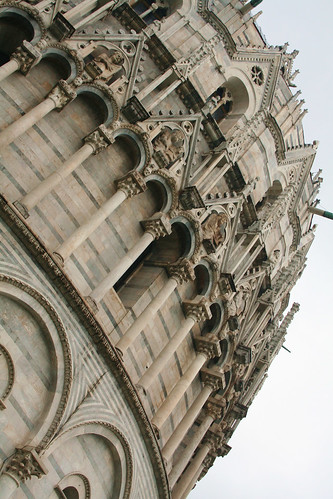
Pisa's Baptistry is the largest in Italy, at 180 feet tall, and it showcases multiple architectural styles reflecting the length of its construction: Romanesque arches (12th century) on the lower level, Gothic (13th century) spires and arches mid-level, and a 15th century Renaissance dome.
The Duomo of Pisa is where the architectural term “Pisan Romanesque” is derived.

The interior is spectacularly painted and frescoed, but no photos were allowed inside, sadly. So, let's focus our attention on that tower.
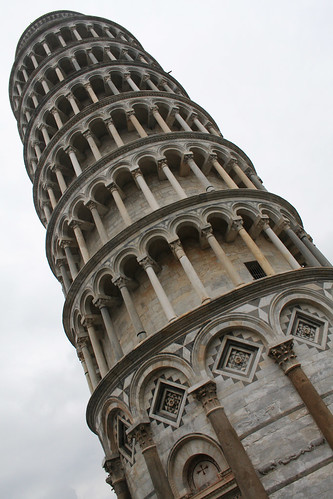
The tower's incline presents some interesting problems when it comes to preservation and restoration. The south side, shielded from erosion from rain and wind, collects airborne dust and pollutants and requires manual cleaning; conversely, the north side suffers much more greatly from erosion and mineral deposits due to the flow of water. The angle of the tower places such stress on the structure itself that parts of the tower—particularly the outer columns, of which only 33 of the total 180 are original—have cracked or fractured.
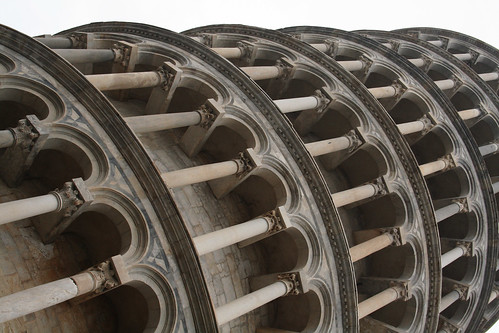
Notice that the very top level, the belfry, appears slightly askew in relation to the rest of the tower. This was an attempt by architect Tommaso Pisano (a descendent of the original designer, Bonnano Pisano) to shift the tower's center of gravity further north and slow its ever-increasing tilt.
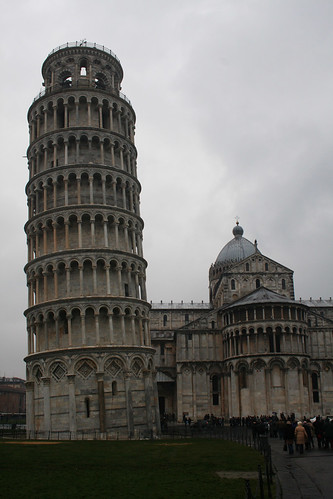
For a measly fifteen euros, you can climb to the top of the tower. Tours are taken up every half-hour. As the groups ascend, peals of dizzied laughter begin to fill the narrow stone passages. The tilt is more than noticeable as you spiral up and up, and the cognitive dissonance between the seemingly-regular stairway and the changing angle of your ascent is... really something. I do not recommend this climb for anyone with vertigo or difficulty balancing. I would also suggest, if you make it to the top, staying on the north side of the belfry.
Still, the view is stunning...

… and they might ring the bells while you're up there.
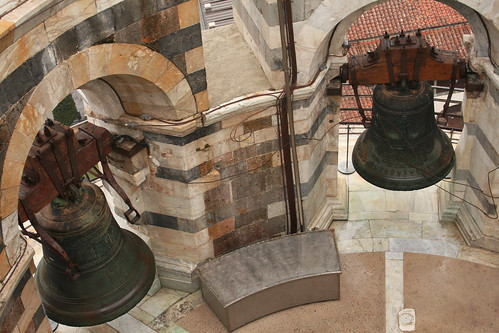
The tower is the only part of Pisa that gets much publicity, but another worthwhile stop is the Cemetery of Camposanto, a narrow, elegant marble structure just north of the Duomo, in which some six hundred prominent Pisans are entombed, many in recycled Roman sarcophagi.

The rectangular structure encloses a lush, bright courtyard, filled with soil that was brought from Jerusalem during the crusades.
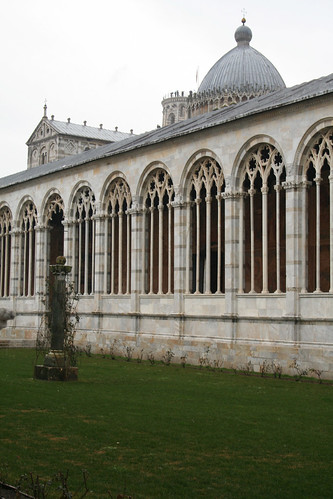
Local legend holds that the soil has magical properties and can reduce a body to nothing but bones within a day. I had neither the time nor the spare bodies necessary to test it out, so a legend it will have to remain...

Camposanto was severely damaged during World War II (and today there are photos on display showing just how extensive the damage was). The roof, originally made of expensive lead tiles, melted when the building was bombed and damaged the frescoes on the walls.


Bit by bit, the frescoes are being restored and returned to their original positions.
Coming up next: some nice weather, for a change, and a look at Siena from several points of view.

No comments:
Post a Comment